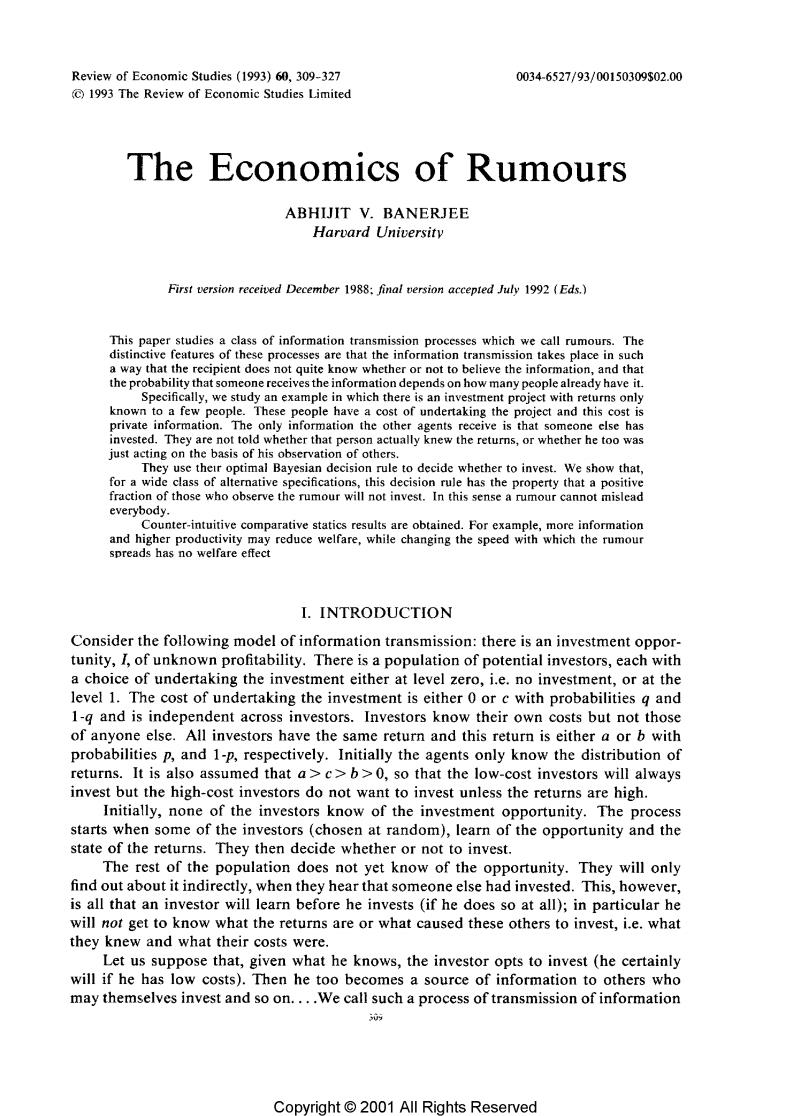正在加载图片...

Review of Economic Studies (1993)60,309-327 0034-6527/93/00150309$02.00 C)1993 The Review of Economic Studies Limited The Economics of Rumours ABHIJIT V.BANERJEE Harvard University First version received December 1988:final version accepted July 1992(Eds.) This paper studies a class of information transmission processes which we call rumours.The distinctive features of these processes are that the information transmission takes place in such a way that the recipient does not quite know whether or not to believe the information,and that the probability that someone receives the information depends on how many people already have it. Specifically,we study an example in which there is an investment project with returns only known to a few people.These people have a cost of undertaking the project and this cost is private information.The only information the other agents receive is that someone else has invested.They are not told whether that person actually knew the returns,or whether he too was just acting on the basis of his observation of others. They use their optimal Bayesian decision rule to decide whether to invest.We show that, for a wide class of alternative specifications,this decision rule has the property that a positive fraction of those who observe the rumour will not invest.In this sense a rumour cannot mislead everybody. Counter-intuitive comparative statics results are obtained.For example,more information and higher productivity may reduce welfare,while changing the speed with which the rumour spreads has no welfare effect I.INTRODUCTION Consider the following model of information transmission:there is an investment oppor- tunity,I,of unknown profitability.There is a population of potential investors,each with a choice of undertaking the investment either at level zero,i.e.no investment,or at the level 1.The cost of undertaking the investment is either 0 or c with probabilities g and 1-g and is independent across investors.Investors know their own costs but not those of anyone else.All investors have the same return and this return is either a or b with probabilities p,and 1-p,respectively.Initially the agents only know the distribution of returns.It is also assumed that a>c>b>0,so that the low-cost investors will always invest but the high-cost investors do not want to invest unless the returns are high. Initially,none of the investors know of the investment opportunity.The process starts when some of the investors(chosen at random),learn of the opportunity and the state of the returns.They then decide whether or not to invest. The rest of the population does not yet know of the opportunity.They will only find out about it indirectly,when they hear that someone else had invested.This,however, is all that an investor will learn before he invests (if he does so at all);in particular he will not get to know what the returns are or what caused these others to invest,i.e.what they knew and what their costs were. Let us suppose that,given what he knows,the investor opts to invest (he certainly will if he has low costs).Then he too becomes a source of information to others who may themselves invest and so on....We call such a process of transmission of information 09 Copyright 2001 All Rights Reserved